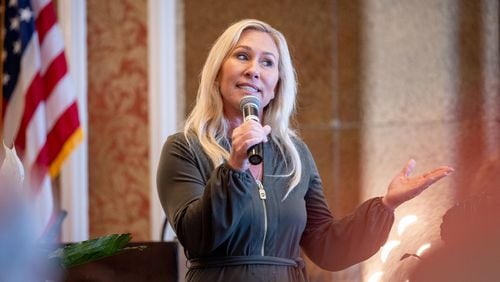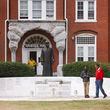The two-lane blacktop dead-ends at a tall fence and guard shack surrounded by pine stands and coastal swamps where wild boars, armadillos and rattlesnakes roam. “Bayer CropScience” reads the sign, a clue to the site’s heritage as a manufacturing depot for insecticides, chemicals and trip flares.
A more uninviting location would be hard to find in Georgia, the beauty of the nearby marshes, Satilla River and Cumberland Island notwithstanding. The 11,000-acre site, though, isn’t an alien environment to the Camden County men reaching for the stars.
After four somewhat frustrating years, local officials have rocketed ahead recently with plans to build a “spaceport” here to launch satellites, supplies and, one day perhaps, people into orbit.
The county took an option last month on a large swath of scrubby land beyond the guard shack and will soon begin an environmental study. It has hired an aerospace engineer to guide the so-called Spaceport Camden Project Team. And it may have convinced once-skeptical Georgia officials that building a launchpad or two is a viable economic development project.
Camden already has some history in space
Space travel isn’t all that far-fetched in this corner of southeast Georgia. In 1960, NASA chose Cape Canaveral over Camden County and Wallop’s Island, Va., as the place to launch the nation’s space program. The world’s largest rocket engine was tested here in a 150-foot-deep pit five years later.
Steve Howard, the administrator for Camden County, envisions liftoffs every month, rocket factories alongside mission control, tourists filling new hotels on I-95 and international renown as Georgia’s Space Coast. The sky, it seems, is the limit.
“Building a spaceport is complex. It’s not everyday thinking. It’s really innovative thinking. It’s really out there,” Howard said during an interview in Woodbine. “This is an exciting opportunity. The biggest challenge is change.”
Not everybody shares Howard’s enthusiasm.
“I don’t want to have to leave my home every time there’s a launch,” said Paula Eubanks, a retired Georgia State professor whose Little Cumberland Island home sits less than five miles from the proposed launchpad. “And I just can’t understand why we need heavy industry on the marsh. But these people see dollar signs and think it’s wonderful. As a taxpayer, I think this is a fool’s errand.”
‘At the beginning of a significant expansion period’
Spaceports no longer reside in a Buck Rogers fantasy world. Ten commercial spaceports dot the country. The latest, in Houston, received Federal Aviation Administration approval in June. “Reusable launch vehicles,” i.e. fast planes, will take off horizontally (as opposed to vertically with rocket boosters) carrying small satellites strapped to their bellies for deployment at high altitudes.
Cecil Field near Jacksonville, Fla., about 70 miles south of Woodbine, is also planning to send satellites aloft.
SpaceX chose Brownsville, Texas, over Georgia and Florida to rocket tourists into the heavens. A dozen other spaceports are planned across the country as NASA curtails exploration and entrepreneurs such as Elon Musk (SpaceX), Jeff Bezos (Blue Origin) and Richard Branson (Virgin Galactic) fill the void.
Location is the Camden site’s strength. Launching over the Atlantic Ocean, from a little-inhabited corner of coastal Georgia, mitigates on-ground damage and death if a launch goes awry. Howard says the spaceport would need only 400 acres; the remaining 10,000 would serve as a buffer zone. The former rocket test site is already kitted out with roads, water, sewer, runway and other industrial amenities.
Rockets, or high-flying planes, could more readily reach orbital and suborbital trajectories than Texas launches, Howard says. Rocket engines or parts could be shipped, via I-95 or barges, to existing launch sites in Florida or Virginia.
“It really doesn’t take a lot to do a spaceport,” said Howard, likening a startup to a glorified industrial park. “It’s literally some concrete launchpads and some limited infrastructure. It’s more about finding the property, the larger the better, and the ability to be out over the water quickly.”
Flight could begin in 2020
Camden County is spending $1 million to option 4,000 acres at the end of Harriet’s Bluff Road. If all goes as planned, the money will be put toward the $4.8 million purchase price. The county also hopes to sew up a 7,000-acre tract owned by Bayer CropScience.
A two-year environmental study, required by the FAA, will soon get underway and could lead to a license to fly, perhaps by 2020.
The space industry worldwide tallies $330 billion, according to the Colorado-based Space Foundation, with commercial activities accounting for three-fourths of that amount. It has nearly doubled in size the past decade. Credit goes largely to the world’s 3 billion mobile device users who rely upon GPS satellites.
The Organization for Economic Cooperation and Development predicts that commercial space travel is “at the beginning of a significant expansion period.” Space Launch Report, an industry publication, tallied 92 launches (with four failures) in 2014, one-fourth lifting off from the United States. A year earlier, there were 81 launches (and three failures).
Despite the surge in activity, industry payrolls continue to shrink due largely to NASA cutbacks. Yet pay for the remaining space workers averages $108,000.
Georgia doesn’t tally the size of its space industry, which is relatively small compared with Florida (Kennedy Space Center) and Alabama (U.S. Space and Rocket Center, Huntsville). Howard couldn’t give a cost estimate to get the spaceport up and running. Nor would he guess how many jobs it would create as a public-private venture.
“It’s a one-third-of-a-trillion-dollar industry now,” Howard said during a presentation two weeks ago in Atlanta at Georgia Tech. “We need to get a share of it.”
State ‘optimistically cautious’ while others question benefits
Jim Renner wants nothing to do with the spaceport. His wife, Shelley, owns land on Little Cumberland Island that they visit twice monthly. They’d be forced off the island, Renner predicts, whenever a rocket is launched.
“There will be no launch trajectory that doesn’t go over the north end of Cumberland and Little Cumberland,” he said. “And all water offshore Cumberland and the south side of Jekyll (Island), as well as the shipping channel for Brunswick and the Intracoastal Waterway, will be closed.”
On launch days the feds impose stringent exclusion zones for boat, plane and car traffic. Airplanes were prohibited from entering a 1,500-square-mile area — larger than Rhode Island — during an aborted April 15 launch by SpaceX at the Kennedy Space Center. It doesn’t boost Camden Spaceport’s prospects that the nuclear submarine base at St. Mary’s sits eight miles away.
The environmental concerns are manifold. Could right whales, a federally endangered species that gives birth in the waters off Georgia’s coast, be threatened by falling debris? Is the property, home to an old landfill, contaminated by chemicals, pesticides and rocket fuel from previous incarnations?
“It’s been presented as this really amazing opportunity, a silver bullet, a win-win for everybody, and nobody on the county side is talking about any potential negative impact the spaceport might have on Camden County,” said Megan Desrosiers, the executive director of One Hundred Miles, an environmental nonprofit in Brunswick. “We have no idea what they’re proposing. If it’s taxpayer dollars, the public should know what those dollars are going for.”
The environmental study should answer some of Desrosiers’ questions. The county administrator promises a “transparent process.” The support so far has been “overwhelming,” he said. And it’s too early to predict who would be ordered to evacuate during launches.
State’s support seen as critical
The spaceport, though, won’t get off the ground without strong state support, assistance that’s been noticeably lacking. A request for a half-million-dollar grant to help defray the cost of the environmental study was turned down by the OneGeorgia Authority, a rural development fund that hands out millions of dollars annually.
Bob Scaringe, who co-founded the Georgia Space Working Group, said at the time that “the state has left Camden County on its own to raise funds, navigate the FAA licensing process and mount a marketing campaign to attract Spaceport tenants. This is not the economic development taxpayers expect.”
Chuck Hunsacker, the state’s former manager for defense and space projects, asked to brief Gov. Nathan Deal on the spaceport numerous times but was never granted an audience.
“They’re kind of lukewarm,” said Hunsacker, a consultant in Columbus. “My view was we ought to go hard right now to recruit as many companies as we could. The state’s position was you can’t sell something you don’t have. We don’t have a spaceport, so they were a bit reluctant to do too much.”
Deal did pitch the Camden County site to SpaceX’s Musk two years ago. Georgia Rep. Jason Spencer, a Republican from Woodbine, said the governor and the Legislature are now “definitely on board” and willing to offer incentives to companies considering the spaceport.
“The state’s being optimistically cautious, as they should be,” he said.
Spencer lives on Harriet’s Bluff Road about seven miles from the site. He knows well the tortuous history of the land at the end of the blacktop: the rocket testing that made Life Magazine in 1965; the presence of poisonous chlorine gas and bug-killing chemicals; the trip flare factory that exploded in 1971, killing 29 people.
Spencer will smile big — with earplugs squarely in place — once the first rocket lifts off from Georgia’s spaceport.
“We’ve come a long way already,” he said.






